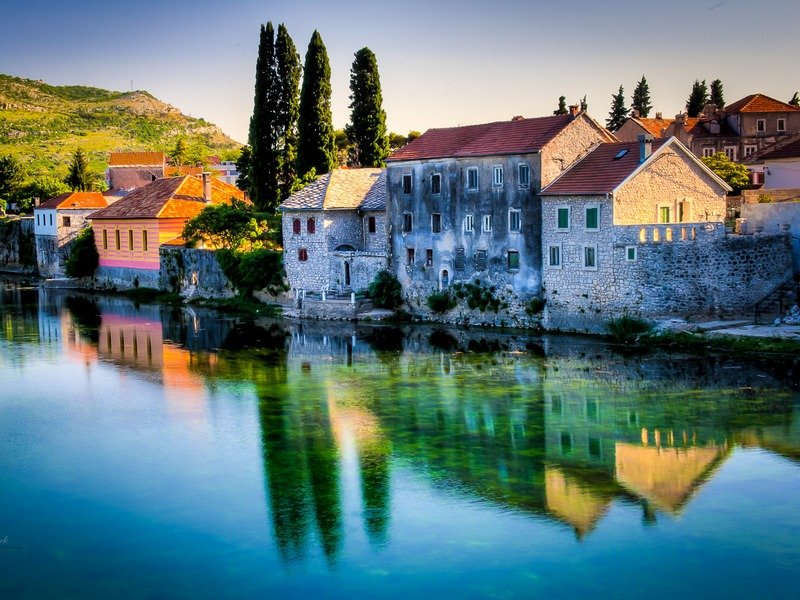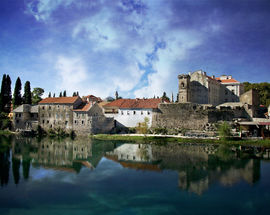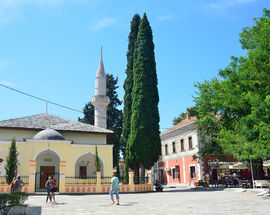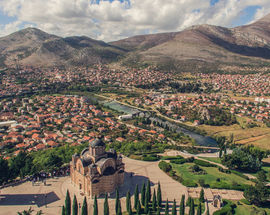Anyway, Constantine VII, Constantine VII Flavius Porphyrogenitus, Κωνσταντῖνος Ζ΄ Φλάβιος Πορφυρογέννητος. The Emperor and Autocrat of the Romans from 913 to 959, a tumultuous life that stuttered before it began, the illegitimate son of Leo the Wise, a leader who presided over the continued degradation of the famous Roman Empire. Still, it was a great time for letters, and our buddy Consto became known for his De Administrando Imperio, a foreign policy booklet to be used by his son and successor.
What does this have to do with Trebinje? Well, our little wonder here features in the book as Travunia and is referred to it as the ‘Land of the Serbs’. The family of Prince Vlastimir was in charge of this town, an important spot on the trade route between Ragusa and Constantinople. A Serbian court was set up here in the 11th century, but the 13th and 14th saw the first real fascinating periods of Trebinje’s history. For 40 years it was ruled by Helen of Anjou, the longest-reigning sovereign in the history of the city. Helen was the Queen Consort of Serbia and ruled over a number of regions, contributing significantly to the development of culture along the way. Libraries, monasteries and education were established, including the first girls' school in Serbia. It couldn’t last forever, nothing does, and the eventual degradation of the Serbian Empire saw Travunija taken over by Tvrtko I as the Bosnian Kingdom reached its apex.

What next? Well, even the most rudimentary of Balkan scholars will be able to guess who was next in line to rule these lands; the Ottoman Empire. Travunija was conquered by Bayezid II in 1482 as the increasingly Islamic empire strengthened its hold on Europe’s eastern frontier. The old town replaced the old fortress, and the Islamic elements of Trebinje began to take shape.
Repeat, repeat, for a few hundred years. Such a dismissive take on centuries of history can only depress, as those years must have been filled with curious personalities and interesting individuals, stories that are now lost to history. Doesn’t bode well, does it? Nevertheless, what we know and love as Trebinje truly began to take shape under the watchful eye of Osman-pasha Resulbegović, the first city chief under the new rulers.
The conquered people of Herzegovina did not go quietly into the night. Rebellions and uprisings were commonplace, with Tvrdoš monastery often acting as the centre of resistance. The first full-scale scuffle came in 1596, but it all fell apart on the field of Gacko. It wouldn’t be the last.

Despite Tvrdoš acting as the centre of resistance, its eventual destruction had nothing to do with the Ottomans, although ‘nothing to do’ is a little bit loose. That destruction came in 1694 at the hands of the Venetians, then fighting with the Ottomans (and trading at the same time, good old history). The destruction of Tvrdoš gets margin space today, but the 17th century was a time of constant tumult in Trebinje, although that had little to do with the locals themselves. The old ‘east and west’ cliche is at its most apparent in these parts.
The balance of power shifted from east to west in the late 19th century, but things didn’t exactly get any better for local people. Any hope that the Austrian occupation would be less intrusive than the Ottoman was shelved immediately when Austrian soldiers massacred anyone and everyone that it considered shifty in the aftermath of Franz Ferdinand’s suicide-assassination. 79 prominent local citizens were hanged, including intellectuals, landowners and other important people. The Austrians built fortresses and infrastructure, but they also, you know, hanged people.
What about life in Yugoslavia? It depends on who you ask, as with everything, but Trebinje grew and prospered during these years, particularly in industry. Dams, artificial lakes and all the rest were built, as Trebinje became the most important town in eastern Herzegovina. This made it an obvious flashpoint during the war of the ‘90s, as the Bosnian Serb army flattened as much of the town’s Ottoman heritage as they could find, razing 10 mosques in the process.

That brings us to today, but there is so much more to the millennia of Trebinje’s history than can be conveyed in 800 or so words. You need to visit to get a better idea, to get under the skin of this gorgeous city, to experience the fluidity of its history through its architecture, tastes, sounds and smells. Trebinje is a product of its history, a history tempered by poets, rebels and a curious combination of both. The Mediterranean with a dash of Ottoman wonder. Undeniably Trebinje.
John Bills loves Trebinje. Who doesn't love Trebinje? Fools, that's who. John's first memory of Trebinje was desperately needing a wee at 4 in the morning, being refused access to a bathroom and buying a bottle of water in his confusion. Everything since then has been magnificent. You can buy John's books about the Balkans here, and read more jabberings here.







Comments